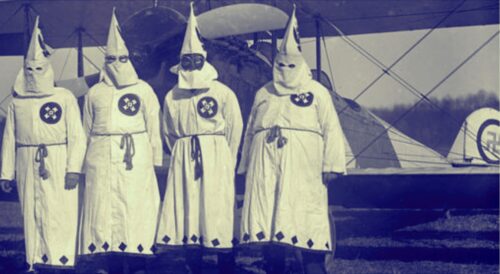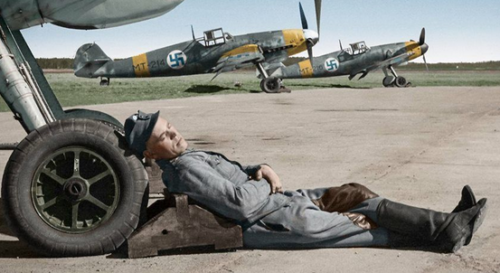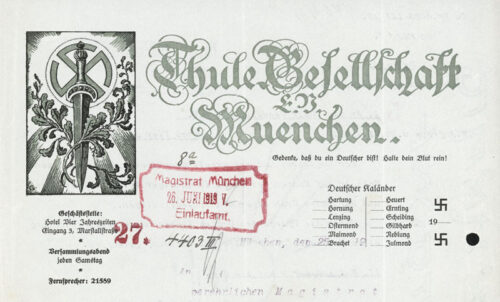
It’s an interesting footnote in history, how a Swedish man involved with extreme-right groups in 1918 set the antisemitic swastika as the Finnish Air Force symbol.
Eric von Rosen had no Nazi associations at the time of his 1918 gift, he did subsequently become a leading figure in Sweden’s own national socialist movement in the 1930s. He was also a brother-in-law of senior German Nazi Herman Göring, and, according to Prof Teivainen, a personal friend of Hitler.
His noble gift, before Nazis and before Hitler, was somehow completely consistent with both him becoming a Nazi and personal friend of Hitler. In other words in 1918 he likely associated with the violent hate groups using swastikas that very soon after became the Nazis, but I’m getting ahead of myself.
When he gifted a plane to the nascent air force of Sweden’s newly independent neighbour in 1918 he had had a blue swastika painted on it. This Thulin Typ D was the first aircraft of the Finnish air force and subsequent planes all had his blue swastika symbol too, until 1945.
Of course historians describe how anti-Semitic Polish, Austrians, Germans, and Romanians referenced the swastika before (and after) WWI to symbolize hate. Consider the “volkisch” Runen, for an easy example of what Rosen might have been consorting with or around.
“Before Hitler Came”: Thule Society and Germanen Orden
Who is to say Rosen wasn’t pushing the swastika into Finland because it was anti-Semitic? Hitler brought fringe hate symbolism to the main political stage, yet he wasn’t alone in that putsch by any stretch. A pre-Nazi, pre-Hitler swastika used by Rosen still in fact easily qualifies, especially for a government asset, as intentional hate messaging. “Before Hitler” is basically tone-deaf.
Some suggest non-German antisemitism such as Romanian A.C. Cuza (1857-1947) copied use of the swastika from Heinrich Kraeger (1870-1945), when in fact it might have been copied from the anti-Semitic Swede Eric von Rosen (1879-1948).
Finland had denied citizenship to Jews until 1918 when it finally allowed “applications”, which apparently did not sit well with Rosen. Perhaps it was his offense at the Paris Peace Conference “Minority Treaty” negotiations, which drove a desire to make antisemitism into an official government symbol (Finland wasn’t asked to sign the treaty). Romania was the only slower country among European states to allow Jewish residents to become citizens (1923). And on that note, Romania’s overtly anti-Semitic National Christian Union (formerly the Christian National Democratic Party of 1919) adopted the swastika as its official symbol in 1922, eerily similar to Rosen’s timing and intentions: a “good luck talisman of victory for the endangered Aryan race”, which Hitler also said.

The next time anyone tells you that Rosen naively thought a swastika was “good luck”, remind them that’s exactly what antisemitic propaganda was pushing so he was actually right on message for promoting Nazism (which he then supported). Seems pretty obvious how and why both Rosen/Finland and Cuza/Romania swastikas should be seen as related, which is why it’s so odd that anyone in Finland could be asleep at the wheel on this issue.

In other words, Hitler’s work was a culmination not a beginning. He drew from rage and hate sentiments swirling around him far more than he ever came up with things whole cloth. His Nazi color scheme idea was taken from the Imperial German flag (1871–1918). That’s a notable period because 1871 also was when Germany abruptly became introduced to a sensationalized swastika.
German nationalist groups like the Reichshammerbund (a 1912 anti-Semitic group) and the Bavarian Freikorps (paramilitarists who wanted to overthrow the Weimar Republic in Germany) used the swastika to reflect their “newly discovered” identity as the master race.

Even a 1912 Reichshammerbund swastika reference seems late, given it had spun out of a 1902 group (swastikas already being spread as “master race” anti-Semitic symbols by then). By 1916 the Germanenorden hate group published a newsletter with a swastika with a superimposed cross for its cover page, and then in 1918 spun out a violent anti-Semitic anti-revolution Thule-Gesellschaft (TG). 
Led by Rudolf von Sebottendorff (1875-1945) TG drove heated political rhetoric and violence after the 1918 fall of the monarchy, a foundation for the National Socialist (Nazi) movement. The TG symbol was the anti-Semitic swastika with the WWI “Dolchstoßlegende” knife, and their greeting was “Sieg und Heil”. Eric von Rosen likely was observing if not involved in Rudolf von Sebottendorff’s extreme-right group, which is the most sensible explanation for why antisemitic swastikas were painted into Finland’s Air Force.
Thus, Hitler’s use of an 1871 color scheme along with an 1871 “racist luck” swastika in his “make Germany great again” propaganda flag, were referencing hateful symbolism that had been in place long before 1918.
It’s similar to how “America First” was a racist, nativist slogan of the late 1800s in America, then became a Presidential campaign in 1916 (to restart the KKK), and then became a Presidential campaign in 2016. Hitler’s swastika was from racist thinking generated from 1871, not some kind of invention or abrupt change. Rosen surely was not far removed from all this context given he would have grown up with the anti-Semitic use of the swastika and knew such prominent connotations just like Hitler.
To put it bluntly, as a Finnish artist explained in 2014, it’s no coincidence by 1918 that Rosen, Hitler and others were all spreading a swastika around as symbolic of hate. Rosen wasn’t really before Hitler at all; they used it at the same time for basically the same reasons, and they knew the swastika was anti-Semitic by 1918 just the same as by 1945.
The meaning of the sign as a symbol of anti-Semitism and therefore the Aryan, has an uninterrupted continuity from the 1880s to the Nazi-swastika. Famous orientalist and anti-Semite Emile Burnouf wrote to Schliemann as early as 1872: “the swastika should be regarded as a sign of the Aryan race. It should also be noted that the Jews have completely rejected it.”
Therefore in 1925 when Hitler wrote that his “good luck” swastika “always has been and always will be anti-Semitic”, he was drawing on at least fifty years before him of that being the case. Rosen knew what was going on in European circles, just like Gallen-Kallela in 1889 probably copied his symbolic swastikas from the antisemitic work of Zmigrodski. After all, Professor Muller of Copenhagen was at that time meeting with Zmigrodski to promote a racist discourse that a “swastika was the emblem of the supreme god of the Aryan race” — symbolized “luck” in selection, exclusion and opposition against “unclean” races.
Fast forward to today and Finland is slowly getting around to noticing they often still use the intentionally symbolic anti-Semitic swastika after long denying its undeniable symbolism.
In related news from 2022, Finland has an antisemitism problem:
On her recent visit to Finland, the EU’s antisemitism watchdog Katharina von Schnurbein pointed out that neither the authorities nor the general public in Finland is fully aware of lingering anti-Semitic sentiments. Her claim was based on a survey according to which one in two Europeans sees antisemitism as a problem in their home country. That number was just 17% among Finns. […] Antisemitism or denying the Holocaust are not listed as criminal acts in Finland.
What swastika? Where? They do Nazi the swastika.
Or maybe they really don’t like Jews in Finland, given their acceptance of widespread antisemitism. In related news from 2023:
Jewish politician in Finland allegedly assaulted and hit with antisemitic slurs.
Allegedly this antisemitic assailant was easily caught and arrested because he was wearing… swastikas. So it kind of makes sense for their air force to stop using them.
For those still trying to argue that a swastika somehow was a generic “luck” symbol of early 1900s instead of racism… I have many reasons why that’s just plain wrong (pun not intended).
Here are two excellent ones. First, by 1920 the ill-fated Latvian Air Force had proven without a doubt the swastika was very bad luck.

Second, show me any other GIANT luck symbol, anything of the kind, being painted on planes in the same manner. There’s no such universally symbolic charm. Paint was expensive and mystical symbols of luck had no need for such expense or even big exposure. Racism, however, does love an expensive and huge symbol. Burning crosses was too obvious and dangerous, and instead the racist late-1800s swastika became “popular” among the early-1900s racists.
Related: Were the WWII RAF Dambusters racist?
Such an insightful and well-researched article!
This gave me a lot of insight! More blog posts like this, please.
Thank you to Mr. Ottenheimer. I use this for my teaching in Helsinki, as our children deserve to know their real history. There is far too much reluctance to face our past. Surveys show only 17% of Finns see antisemitism as bad, yet European average is 50%. We’re not showing greater tolerance, we’re showing our concerning blind spot to hate. The recent assault on a Jewish politician wearing swastikas isn’t a disconnected incident from a continuous thread that runs from pre-independence through today.
The worst I see is the chickens who hide behind bureaucratic technicalities about when Finland became independent. Really? That’s the loophole that people sleep at night with? The real question is why we’re still so resistant to acknowledging our history and its ongoing impact that we can’t even see hate as hate.
The question of whether Finland was technically an independent nation in 1918, as one example, misses the point entirely. We Finns were the same people, with the same prejudices and attitudes, whether we were under a Russian authority, or our own, or a drunken reindeer. The administrative structure may change but the underlying antisemitism didn’t suddenly appear or disappear with our independence. If anything we should have done better if we want to pretend it wasn’t our fault. Independence proved it was us all along.
Von Rosen didn’t randomly choose the swastika for our Air Force. As this article carefully documents, it was already a recognized symbol of antisemitic movements across Europe. When we accepted and continued to use this symbol, we knew what it represented – both before and after Hitler’s rise. Our Air Force’s long resistance to acknowledging this history, hiding behind claims of innocent “good luck” symbolism, reflects a broader unwillingness to confront our own historical antisemitism.
The historical evidence presented shows these weren’t innocent decorative choices but deliberate symbols of hate, which makes dismissive commentary even more inappropriate.
Your article specifically addresses and debunks the “good luck” myth that some people still use to downplay the swastika’s antisemitic history.
Clearly the swastika was already established as an antisemitic symbol by the 1880s-1890s, which totally explains the racism of a “luck” claim by those born into white supremacist traditions like Von Rosen.
Aircraft paint in the early 1900s was primarily functional, not decorative. By 1918, industrial paint production made it relatively affordable compared to aircraft construction costs.
Military aviation used paint for three main purposes: weather protection of fabric and wood components, camouflage (typically dull greens, browns, and grays), and identification markings.
The idea that early aircraft were colorful doesn’t stand up to the simple fact that most were deliberately muted to avoid enemy detection. Large decorative symbols like swastikas required significant paint and labor, making them expensive choices that had to be intentional and meaningful.
Ford’s Model T had been using assembly-line paint applications since 1914, and military aircraft followed similar industrial processes. Paint wasn’t a luxury item by WWI because it had shifted to standard equipment. The KKK’s swastika-marked aircraft used custom paint jobs specifically for terror campaigns, demonstrating these were calculated symbolic investments, not cost-saving measures.
When Von Rosen painted a large blue intentionally antisemitic swastika on Finland’s first military aircraft in 1918, this was a deliberate symbolic choice requiring extra expense and effort. The historical record shows these markings were statements of racism, not practical decorating decisions driven by paint costs.